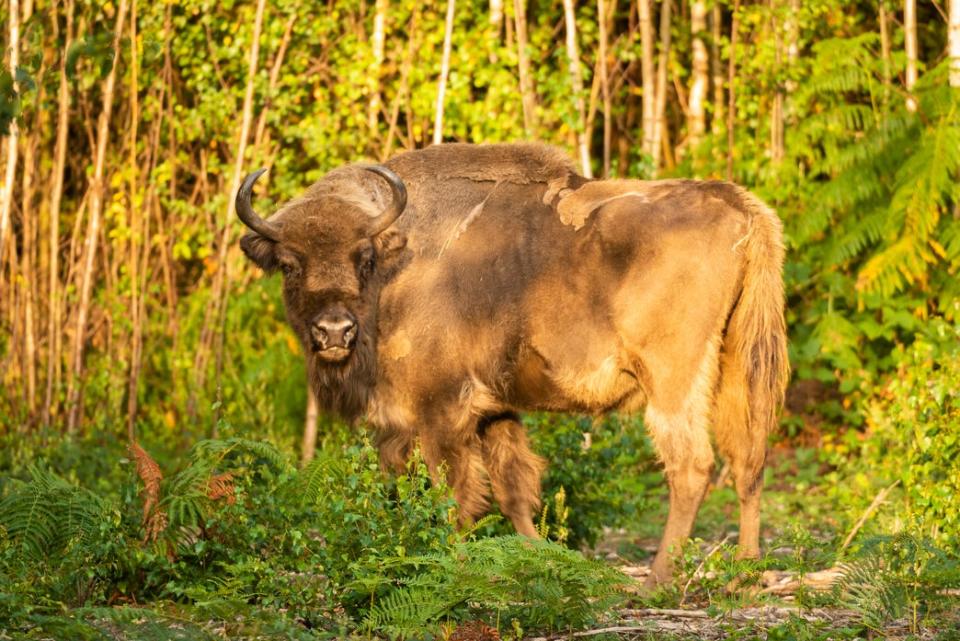UK forest is home again for European bison, which haven't roamed there for 6,000 years
For the first time in 6,000 years, European bison are back in the British woodlands.
The bison, three females and one bull, were released early Monday morning into a wooded area in Kent called West Blean. The release, organized by conservation organizations Kent Wildlife Trust and Wildwood Trust, is part of a project to combat climate change and increase biodiversity.
The release is a trial, but experts would like to see similar projects across the United Kingdom, said Paul Hadaway, director of conservation at Kent Wildlife. "We've got some interesting regulations and legislation to sort out before we can really make that happen," he told USA TODAY.
The bison is Europe's largest land mammal and weighs up to a ton. They weigh less than American bison but are slightly taller, he said.
The European bison went extinct in the prehistoric U.K. after "we lost our land bridge to Europe around 12,000 years ago," Hadaway said. In Europe, the bison "hung on until almost becoming extinct" after World War I, he said.
Bison will be bred on site, as part of a revitalization project that also includes wild ponies, pigs and longhorn cattle. The goal? "This kind of complete grazing assemblage of all of these species," he said. "(They) interact in different ways with the habitat and create a much more naturalistic kind of ecosystem."
Bison galore: Too many bison or tourists? Graphics profiles the bison of Yellowstone National Park
Bison sightings: Yellowstone bison walks by Old Faithful at the perfect moment
So, how do bison help the ecosystem?
Releasing bison into the area will improve conditions for other species and make the environment more resilient to climate change, Hadaway said.
Bison are primarily woodland animals that graze differently from cattle and ponies. Bison rub against trees to take their winter fur off, which leaves the trees stripped of their bark, creating the ideal conditions for invertebrates such as mining bees, beetles and butterflies to thrive, he said.
The animals also create areas of open ground where they dust bathe, or roll around on the dry ground. "Those dust balls create habitats for quite rare invertebrates," Hadaway said.
Bison also carry seeds on their coats, spreading them about as they travel, Hadaway said.
Lastly, the bison may create a more diverse ecosystem that can better absorb greenhouse gases. In addition to rubbing against trees, they also eat leaves and tree bark, which eventually wears down trees and – in a process called coppicing – results in new growth from the worn-down trees.
The conservation evidence team expects them to get through potentially nine trees a day, "naturally coppicing them," or allowing more stems will grow back. That's important to the ecosystem because young, growing trees take in more carbon dioxide, he said.
And letting the bison maintain the habitat is cheaper than manual maintenance, Hadaway said.

Bison have been released. What now?
The bison now roam a fenced area of about 1,000 acres of a nature reserve in southeastern England without interruption from people, Hadaway said.
"What I hope long-term is that we can at least take down one of those two fences so that they are able to much more freely exhibit their behaviors," he said.
Prior to the release of the bison, the conservation team monitored the reserve area's flora and fauna. As the bison move throughout the area, the team can track the bison's impact.
The animals have collars on them so they can be tracked – allowing researchers to understand bison behaviors. If the animals, for example, have stomach problems, "they'll find the plants that give them that roughage," Hadaway said. "We have to relearn all of that … because they haven't ever been there."
Saleen Martin is a reporter on USA TODAY's NOW team. She is from Norfolk, Virginia – the 757 – and loves all things horror, witches, Christmas, and food. Follow her on Twitter at @Saleen_Martin or email her at sdmartin@usatoday.com.
This article originally appeared on USA TODAY: UK forest is where the bison roam, for the first time in 6,000 years

